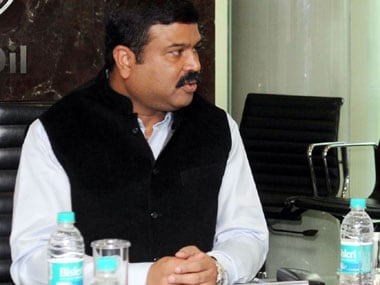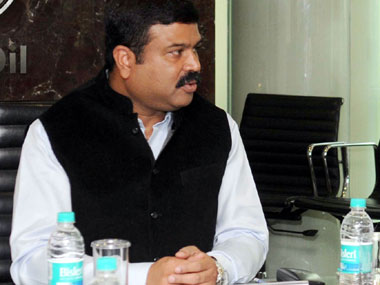Dharmendra Pradhan has turned out to be an unexpected reformer. Narendra Modi’s Minister of State for Petroleum – helped, no doubt, by falling global oil prices - first deregulated diesel, then implemented the direct benefits transfer scheme for cooking gas, thus partially deregulating it as well, and
now looks set to liberate natural gas pricing, too.
[caption id=“attachment_2109713” align=“alignleft” width=“380”]
 Minister of State for Petroleum and Natural Gas Dharmendra Pradhan. Image courtesy PIB[/caption] Yesterday (2 September) Pradhan announced that gas discovered in 69 marginal fields of ONGC and Oil India can be sold and marketed by private parties without government interference on pricing. The fields, estimated to contain oil and gas worth around Rs 70,000 crore, will be given out for 20 years to bidders. Even better, companies will bid for these fields on a revenue-sharing basis. This is great. This means the old contentious production-sharing contract (PSC) will be buried. The PSC route, which allowed exploration and production companies (EPCs) to recover their drilling and investment costs before giving government its share of “profit oil”, was messy. It created huge scope for disputes over “gold-plating” of investments and suppression of production figures. In the past, it led to much acrimony between the government and Reliance Industries over how much the company had invested and how much cost it was entitled to recover before giving the government its profit share. The case in now in arbitration. Now, the scope for disputes and mistrust – and hence suspicions of crony deals – will more or less shrink. The government will simply collect a share of topline revenues generated from gas sales, and companies do not have to haggle about what they invested. Government does not have to wonder if it is being gypped of revenues unfairly. Presumably, if this revenue-sharing format works, the government can offer a migration to revenue-sharing contracts even for the older fields. This is exactly what happened with the Vajpayee government’s New Telecom Policy of 1999, which rescued mobile telephony from the curse of high prices and low growth, thanks to the very high bids made by licensees. A committee under Jaswant Singh allowed mobile companies to shift to a revenue-sharing mode, and soon the industry boomed. This could happen in gas too under NDA-2 if the formula is extended to older gasfields which are currently under production-sharing contracts (PSCs). Currently, thanks to the politicisation of gas pricing before the last general elections, when Arvind Kejriwal made it a big issue, the Modi government opted for a sub-optimal solution where prices were fixed by the government according to a hybrid formula based on gas prices in major global gas markets. As things stand today, offshore gas producers like ONGC and Reliance Industries get $5.06 per mmBtu (million metric British thermal units) based on net calorific value (NCV). The rate is now set to fall further to around $4.16-4.17 per mmBtu, reports Mint
newspaper, based on the weighted average global prices at four gas hubs: the US’s Henry Hub, the UK’s National Balancing Point, Alberta (Canada) and Russia. Rates in India are set for six months at a time based on average prices in these hubs in the previous quarter. The next rate change will be effective from 1 October, and if current gas price trends are any guide, the new rate will be even lower than what it was when the UPA last set the price at $4.2 per mmBtu. Towards the end of the UPA regime, a committee led by C Rangarajan, former chairman of the PM’s Economic Advisory Council, had recommended a rate of $8.4 per mmBtu, but the new NDA government lowered this to $5.61 in October 2014. At the US Henry hub, natural gas spot prices are currently as low as $2.75 per mmBtu. The lesson in all this is that when governments try to intervene in the markets, either the company or the consumer gets gypped. By trying to set prices of a commodity whose price changes every day, the government is essentially playing god. In doing so, it denies companies the benefit of higher prices for taking risks in gas exploration when the markets are bullish. But companies also take a hit when global prices fall. By deciding to regulate prices, the government contributes to production and pricing uncertainties. Hopefully, Pradhan will gradually allow a full shift to market-based pricing for gas produced even in the older fields. This will encourage more private players to opt for gas exploration because they no longer have to worry about arbitrary government interventions. ONGC, which produces 85 percent of offshore gas, will benefit most, followed by Reliance Industries. But only if global prices move upwards. It is possible to say Pradhan could have moved faster, but given that reform has stalled elsewhere, his pace cannot be called slow. In any case, direction matters more than just pace. And Pradhan has been moving in the right direction so far. Two cheers are due, if not three. (Disclosure: Firstpost is part of Network18 Media & Investment Limited which is owned by Reliance Industries Limited.)
Minister of State for Petroleum and Natural Gas Dharmendra Pradhan. Image courtesy PIB[/caption] Yesterday (2 September) Pradhan announced that gas discovered in 69 marginal fields of ONGC and Oil India can be sold and marketed by private parties without government interference on pricing. The fields, estimated to contain oil and gas worth around Rs 70,000 crore, will be given out for 20 years to bidders. Even better, companies will bid for these fields on a revenue-sharing basis. This is great. This means the old contentious production-sharing contract (PSC) will be buried. The PSC route, which allowed exploration and production companies (EPCs) to recover their drilling and investment costs before giving government its share of “profit oil”, was messy. It created huge scope for disputes over “gold-plating” of investments and suppression of production figures. In the past, it led to much acrimony between the government and Reliance Industries over how much the company had invested and how much cost it was entitled to recover before giving the government its profit share. The case in now in arbitration. Now, the scope for disputes and mistrust – and hence suspicions of crony deals – will more or less shrink. The government will simply collect a share of topline revenues generated from gas sales, and companies do not have to haggle about what they invested. Government does not have to wonder if it is being gypped of revenues unfairly. Presumably, if this revenue-sharing format works, the government can offer a migration to revenue-sharing contracts even for the older fields. This is exactly what happened with the Vajpayee government’s New Telecom Policy of 1999, which rescued mobile telephony from the curse of high prices and low growth, thanks to the very high bids made by licensees. A committee under Jaswant Singh allowed mobile companies to shift to a revenue-sharing mode, and soon the industry boomed. This could happen in gas too under NDA-2 if the formula is extended to older gasfields which are currently under production-sharing contracts (PSCs). Currently, thanks to the politicisation of gas pricing before the last general elections, when Arvind Kejriwal made it a big issue, the Modi government opted for a sub-optimal solution where prices were fixed by the government according to a hybrid formula based on gas prices in major global gas markets. As things stand today, offshore gas producers like ONGC and Reliance Industries get $5.06 per mmBtu (million metric British thermal units) based on net calorific value (NCV). The rate is now set to fall further to around $4.16-4.17 per mmBtu, reports Mint
newspaper, based on the weighted average global prices at four gas hubs: the US’s Henry Hub, the UK’s National Balancing Point, Alberta (Canada) and Russia. Rates in India are set for six months at a time based on average prices in these hubs in the previous quarter. The next rate change will be effective from 1 October, and if current gas price trends are any guide, the new rate will be even lower than what it was when the UPA last set the price at $4.2 per mmBtu. Towards the end of the UPA regime, a committee led by C Rangarajan, former chairman of the PM’s Economic Advisory Council, had recommended a rate of $8.4 per mmBtu, but the new NDA government lowered this to $5.61 in October 2014. At the US Henry hub, natural gas spot prices are currently as low as $2.75 per mmBtu. The lesson in all this is that when governments try to intervene in the markets, either the company or the consumer gets gypped. By trying to set prices of a commodity whose price changes every day, the government is essentially playing god. In doing so, it denies companies the benefit of higher prices for taking risks in gas exploration when the markets are bullish. But companies also take a hit when global prices fall. By deciding to regulate prices, the government contributes to production and pricing uncertainties. Hopefully, Pradhan will gradually allow a full shift to market-based pricing for gas produced even in the older fields. This will encourage more private players to opt for gas exploration because they no longer have to worry about arbitrary government interventions. ONGC, which produces 85 percent of offshore gas, will benefit most, followed by Reliance Industries. But only if global prices move upwards. It is possible to say Pradhan could have moved faster, but given that reform has stalled elsewhere, his pace cannot be called slow. In any case, direction matters more than just pace. And Pradhan has been moving in the right direction so far. Two cheers are due, if not three. (Disclosure: Firstpost is part of Network18 Media & Investment Limited which is owned by Reliance Industries Limited.)
Free pricing of gas: Two cheers for Dharmendra Pradhan, Modi's oil reforms hero
R Jagannathan
• September 3, 2015, 16:03:50 IST
One area where reforms are directionally in the right direction is petroleum. Dharmendra Pradhan is now moving towards freeing gas pricing.
Advertisement
)